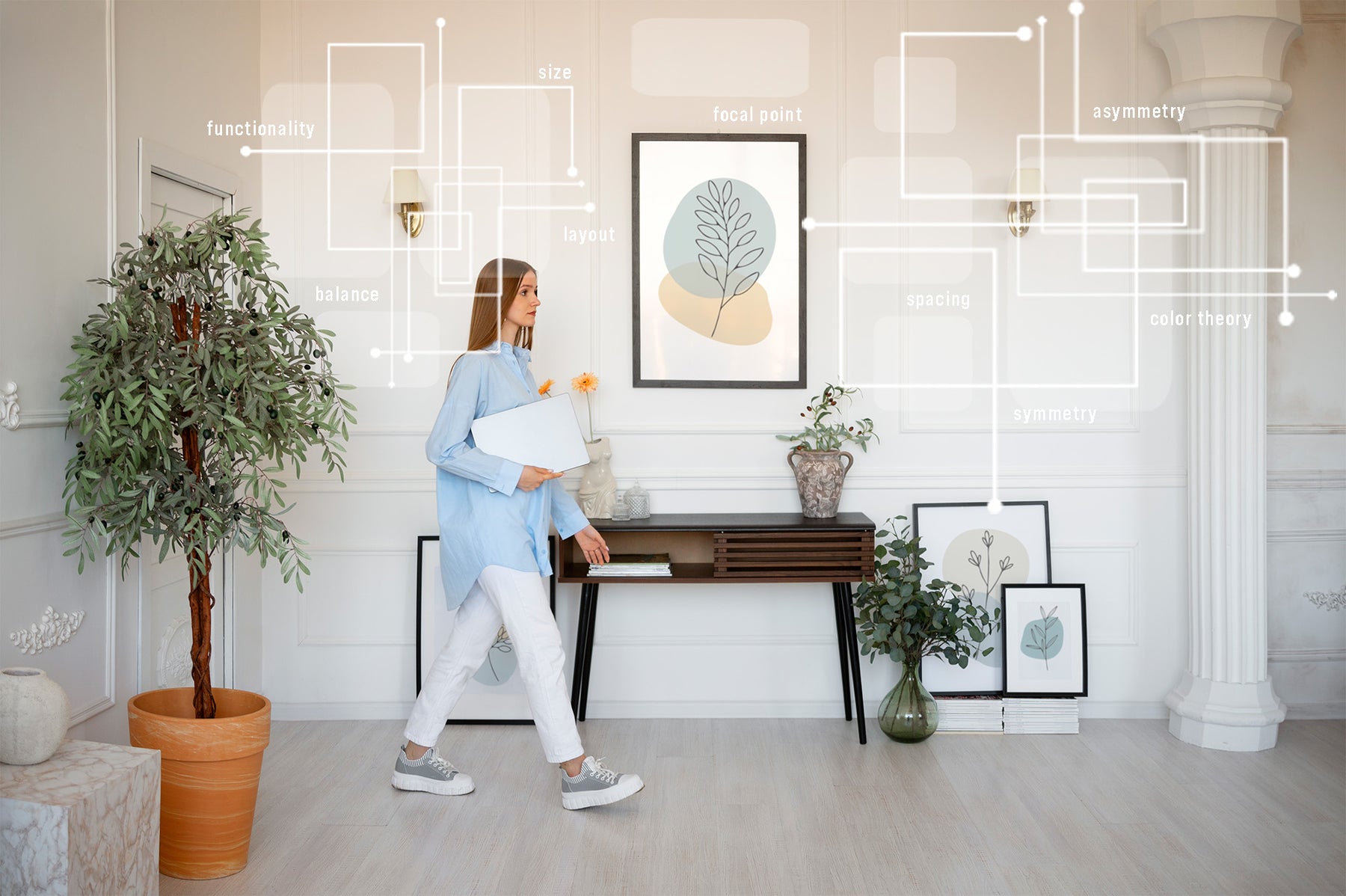
How to Arrange Wall Art: 12 Expert Tips
Ever feel like your walls are a blank canvas, just waiting for a touch of magic? Let's turn that thought into reality! In "How to Arrange Wall Art: 12 Expert Tips," we're spilling the beans on how to give your walls a makeover that screams. Think of this as your secret playbook to transform those empty spaces into a gallery that captures your unique flair. Ready to elevate your wall game? Let’s roll up our sleeves and dive in!
1. Hanging Art at the Right Height
Hanging your art at the right height is key to creating a visually pleasing wall display. The golden rule here? Center your artwork at eye level. This typically means positioning the center of the artwork about 57 to 60 inches off the ground. Why this height? It's the average eye level for most people, making your art easily viewable and enjoyable.
But here's a twist: the context matters. In rooms where you tend to sit down, like living rooms, consider hanging art a tad lower. This way, the art remains at eye level when you're lounging on a sofa or chair. It's all about creating a comfortable viewing experience.
Remember, this isn't a one-size-fits-all rule. Play around a bit. If your ceilings are lower, or if you're placing art in a child's room, adjust accordingly. It's your space – make sure it feels right to you!

2. Art and Furniture Cohesion
Art isn't just about what hangs on your walls; it's about how it interacts with everything else in the room, especially your furniture. When hanging art above furniture like a sofa or a console table, aim for a sense of balance and proportion.
Here's a handy tip: the art piece (or group of pieces) should ideally be about two-thirds the width of the furniture below it. This creates a cohesive look, tying the art and furniture together. Also, start about 8 to 10 inches above the furniture to give some breathing space but maintain a connected feel.
But wait, there's more to consider. Think about functionality – you don't want art that gets in the way. If you're hanging something above a bench or a desk, ensure there's enough headroom. And if it's above a heating element like a radiator, think about the heat's impact on the artwork over time.
These first two tips are all about striking that perfect balance between aesthetics and practicality. It’s not just about hanging art; it’s about integrating it seamlessly into your living space.
3. Embracing Symmetry in Art Arrangements
Symmetrical arrangements are like the classic black dress of wall art – they never go out of style. Perfect for bringing a sense of calm and order to your space, these arrangements work wonders in formal settings or if you just love a clean, structured look. Here's how to nail it:
- Grid or Row Format: Ideal for a set of four to six pieces, try arranging them in a neat grid or a horizontal row. Make sure the spaces between each piece are almost identical. This approach works wonders over furniture or in long hallways.
- Same Size and Frame: To really ace the symmetrical look, use pieces that are the same size and have identical frames. It brings a harmonious and cohesive feel to the space.

4. Asymmetrical Wall Art for Dynamic Energy
Now, if you're someone who likes a bit of zest and personality in their decor, asymmetrical arrangements are your go-to. Less structured and more eclectic, they're perfect for expressing your unique style. Here are some tips to make asymmetry work:
- Mix and Match: Combine different sizes, styles, and orientations. Throw in various frame types and widths for an eclectic mix.
- Gallery Walls: Ideal for creating a salon-style display, a gallery wall allows you to intersperse paintings, photographs, prints, and even unique items like wall sculptures or mirrors.
- Maintaining Balance: While asymmetry allows for creativity, remember to keep a visual balance. Mix larger pieces with smaller ones and distribute colors and textures evenly.
Switching up the format, these sections offer a mix of succinct bullet points and brief paragraphs, ensuring the content remains engaging, varied, and easy to follow.
5. Crafting a Cohesive Gallery Wall
Gallery walls are like a symphony – each piece plays its part in creating a stunning visual narrative. Here's how to create a gallery wall that's harmonious yet full of character:
- Choosing a Focal Point: Start with one piece that draws the eye – this could be the largest item or the one with the boldest colors. Build your gallery around this, adding smaller pieces that complement it.
- Theme and Variety: Decide on a theme or a common element (like color scheme or subject matter) to bring a sense of unity. But within this theme, vary the sizes and frames for an intriguing mix.
- Layout Planning: Before you start hammering nails, lay out your arrangement on the floor or use craft paper cutouts on the wall. This step is crucial for visualizing the final look and avoiding unnecessary holes in your wall.

6. Mastering the Mix in Gallery Walls
A great gallery wall is a mix of different elements, brought together in a way that looks effortlessly stylish. Here’s how to get the mix just right:
- Style Fusion: Blend different art styles – like modern abstracts with classic landscapes. The key is to find a unifying element, be it color, texture, or frame style.
- Adding Personal Touches: Don’t shy away from including personal items like family photos, children’s artwork, or souvenirs from your travels. These elements add a unique, intimate touch to your gallery wall.
- Creative Layouts: Go beyond the traditional grid. Think about staggered arrangements, overlapping frames, or even extending the gallery around a corner. The more creative, the better!

7. Utilizing Color Theory in Art Selection
Choosing wall art isn't just about the subject or style; colors play a crucial role too. They can set the mood, create a theme, or tie together disparate elements in a room. Here's how to use color theory to your advantage:
- Complementary Colors: This involves selecting artwork with colors that are opposite each other on the color wheel. For example, blue and orange, or red and green. This contrast can create a vibrant, energetic feel in your space.
- Analogous Scheme: These are colors next to each other on the color wheel, like blue, green, and yellow. They help in creating a harmonious and cohesive look, perfect for a tranquil and serene space.
- Monochromatic Tones: Different shades or tones of the same color can add depth and sophistication to your space. It's ideal for highlighting the architectural features or furnishings of a room.

8. Adapting Art to Different Spaces
Your art should evolve with your living spaces. A change in room layout or moving to a new home might mean your old art arrangements need a refresh. Here are some tips:
- Reconsider Groupings: The set of frames that once hung horizontally might now look better vertical. Don't be afraid to break up a set or regroup pieces for a fresh look.
- Flexible Layouts: Be open to changing the layout of your artworks to suit the new space. What worked in a cozy living room might not suit a spacious bedroom.
- Mirrors and Alternatives: Incorporate mirrors or other decorative items like textiles or plates into your arrangements. Mirrors can especially help in making a room feel larger and more open.

9. Balancing and Spacing in Gallery Walls
Getting the spacing and balance right is crucial for a gallery wall that looks intentional and not haphazard. Here's how to strike that perfect equilibrium:
- Even Spacing: As a general rule, maintain about 2 to 3 inches between each frame. This spacing keeps the gallery from feeling cluttered or disjointed.
- Visual Weight: Pay attention to the visual weight of each piece. Balance heavier pieces (either in size or color) with lighter ones across your arrangement. This doesn’t necessarily mean symmetrical, but rather a distribution that feels even and cohesive.
- Height and Alignment: While varying the sizes and shapes of the artworks, align the tops or bottoms of frames for a clean, linear look in some areas. This tactic can create a sense of order within the diversity.

10. Art Placement Over Mantelpieces and Furniture
The space above mantelpieces and furniture like couches and beds is prime real estate for art. Here's how to make the most of these spaces:
- Proportional Sizing: The artwork should generally not be wider than the furniture piece it's hanging over. For a couch or bed, aim for art that spans about two-thirds of the furniture's width.
- Height Considerations: For art above a couch or bed, leave about 8 to 10 inches of space between the top of the furniture and the bottom of the art. This gap prevents the art from feeling like it's looming over the furniture and provides a visual breather.
- Functionality: Be mindful of the practical aspects. If it’s above a couch, ensure it's high enough to avoid being bumped. Over a mantelpiece, consider the heat and steam that may rise, which could damage certain types of artwork over time.

11. Thinking Beyond Conventional Walls
Who says art has to be confined to traditional walls? Get creative with where you hang your artwork:
- Utilize Unconventional Spaces: Think about placing art in alcoves, on staircase walls, or even on shelves. These unconventional spaces can become focal points in your room, adding depth and interest.
- Secure Fixtures: When venturing beyond standard walls, ensure your fixtures are secure, especially in uneven or tricky areas like tiled walls or around windows.
- Play with Perspectives: Hanging art in unexpected places can change the perspective of the room. For example, art hung low in a hallway can draw the eye down, elongating the space.

12. Incorporating Non-Traditional Elements
Mixing in non-traditional elements can add a unique twist to your wall art arrangement:
- Beyond Paintings and Photos: Think about adding items like decorative plates, mirrors, or woven baskets to your wall display. These elements can add texture and contrast to your arrangement.
- Textiles as Wall Art: Tapestries, quilts, or even attractive rugs can be hung on walls for a soft, yet striking, visual effect.
- Dimensional Pieces: Incorporating three-dimensional items like small sculptures or shadow boxes adds depth and intrigue to your wall art display.

Conclusion: Unleashing Your Wall Art Potential
And there you have it – twelve expert tips to elevate your wall art game! Whether it’s creating a gallery wall that tells your story, playing with color theory to set the mood, or breaking the mold with unconventional placements, the world of wall art is your oyster. Remember, the best wall displays are the ones that reflect your personality and resonate with your lifestyle. Don’t be afraid to experiment and switch things up. After all, your home is an ever-evolving canvas that mirrors your life’s journey.

Leave a comment